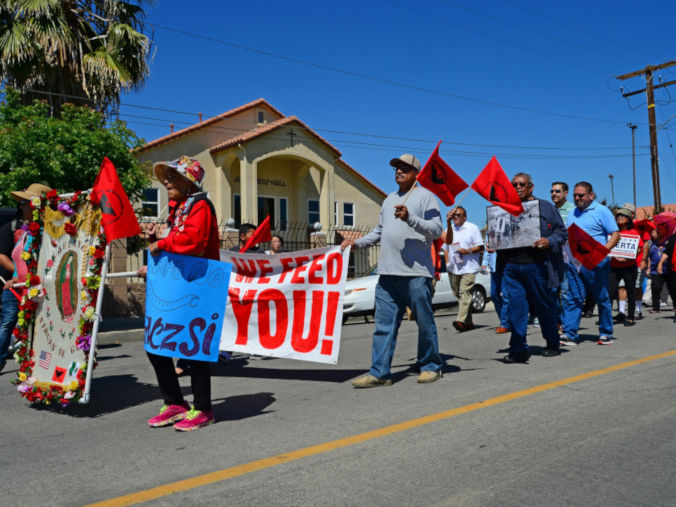Heat waves’ uncounted death toll on workers
In most of the United States, bosses forcing workers to labor in deadly heat is totally legal. July 4, 2023, was the hottest day in recorded history. This year, June and July have set and broken records in the United States, with more than 100 million people living under heat advisories for weeks.

Thousands joined United Farm Workers to pressure Gov. Gavin Newsom to sign a bill making it easier for farmworkers to vote in union elections, in Sacramento, California on Sept. 28, 2022. (Photo: Richard Thornton)
It’s not just in the U.S. where heat is raging. Throughout most of the Northern Hemisphere there have been waves of extreme heat, wildfires, floods and heavy rain.
China set an all-time record for extreme heat. Europe, the Middle East and North Africa were sweltering almost everywhere. El Niño, a known periodic, warming climate change, combined with capitalist-created global warming, is producing an extraordinary spell of intense and long-lasting heat.
These phenomena received a huge amount of media attention, with articles and videos on how to survive the heat, its impact on the electric grid, the economy, sports, commuting, the rich, the homeless, wildlife and on and on. Little has been written on the impact on workers.
Heat’s impact on workers
If a roofer gets dizzy from the heat and falls to their death, the fall is going to be listed as a cause of death, not the heat. A trucker missing the back-up beep on a heavy vehicle, because they have a heat induced headache, will get listed as a vehicular accident, not heat-related. The death of an undocumented farmworker from lack of water will likely never be listed.
So, statistics that the Bureau of Labor Statistics have on environmental heat deaths — 436 from 2011-2021 — and on serious injuries from heat — more than 70,000 workers from 1992 to 2017 — are undercounts.
While OSHA (Occupational Safety and Health Administration) has published some suggestions from the National Institute for Occupational Safety and Health (NIOSH) on how to deal with workplace heat stress, it has not created rules which would be legally enforceable mandates specifying breaks, access to shade and water, health monitoring and acclimatization — the process of gradually building tolerance to heat.
President Joe Biden directed OSHA to begin creating mandates in 2021, and OSHA expects to have its rules by 2028 or so, because such rules get a lot of corporate resistance. More than 130 labor and environmental organizations, as well as some states’ attorneys general, have called on OSHA to issue emergency rules, which would push more states to create their own rules.
California, Oregon and Washington state have heat standards for all outdoor laborers. Maryland and Nevada are currently trying to come up with enforceable guidelines; the ones they have are generally considered too vague.
Colorado’s standards apply only to agricultural workers. Minnesota has a standard for only indoor workers, because its climate is generally cool. New York state proposed a bill dealing with standards for both heat and cold stress, which arrived at the state legislature, only to die in committee. There were similar attempts in other states, but none of them ever went to a vote.
Texas shows the pressures that thwart effective worker protections against heat stress. In Texas, at least 42 workers died from heat exposure between 2011 and 2021, according to the U.S. Bureau of Labor Statistics. Austin and Dallas, two of the largest cities in Texas, responded to this crisis by passing local laws requiring 10-minute breaks every four hours for construction workers so they can get hydrated and cool down under shade. Many of the impacted workers are Latiné.
In the middle of June, Gov. Greg Abbott signed a bill removing the authority of Texas cities to pass such laws. He touted his bill as creating more jobs by making regulations more consistent, since they no longer exist.
Texas state Sen. Brandon Creighton, a Republican, tweeted that this bill is, “the most pro-business, pro-growth bill passed in the 88th Legislative session.” Ana Gonzalez, Texas AFL-CIO Deputy Policy Director, told the Texas Tribune, “We will see more deaths, especially in Texas’ high temperatures.”
Workers can’t rely on arbitrary state or local legislation. Their best protection from work-related heat stress is a union contract.

